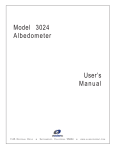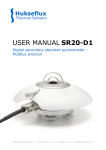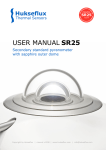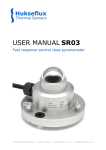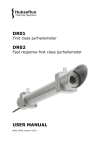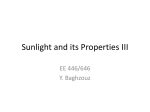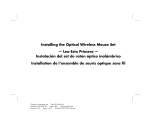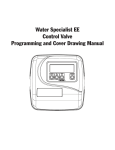Download 3016 Secondary Standard Pyranometer
Transcript
Model 3016 Secondary Standard Pyranometer User’s Manual 1165 NATIONAL DRIVE • SACRAMENTO, CALIFORNIA 95834 • WWW.ALLWEATHERINC.COM 3 0 1 6 Secondary Standard Pyranometer TABLE OF CONTENTS INTRODUCTION ....................................................................................... 1 THEORY OF OPERATION ........................................................................ 2 General Description .............................................................................. 2 Accuracy ............................................................................................... 3 INSTALLATION .......................................................................................... 6 Location ................................................................................................ 6 Mounting ............................................................................................... 6 MAINTENANCE......................................................................................... 9 Recalibration ...................................................................................... 10 CALIBRATION ......................................................................................... 10 SPECIFICATIONS ................................................................................... 11 PARTS LIST ............................................................................................ 13 3016 User’s Manual ii 3 0 1 6 Secondary Standard Pyranometer INTRODUCTION The Model 3016 pyranometer is designed for measuring irradiance (radiant-flux, Watt/m2) on a plane surface, which results from direct solar radiation and from the diffuse radiation incident from the hemisphere above. Because the 3016 exhibits no tilt dependence, it can measure solar radiation on inclined surfaces as well. In the inverted position, reflected solar radiation can be measured. For measuring the diffuse component of solar radiation only, the direct solar component can be shielded semiautomatically from the pyranometer using the Model 30167 Shadow Ring. The 3016 pyranometer complies with the specifications for “secondary standards”, the best of three classes as published in the Guide to Meteorological Instruments and Methods of Observation, Fifth Edition, 1983, of the World Meteorological Organization (WMO)—Geneva, Switzerland. The WMO classification list is adopted, improved, and extended by the International Standard Organization (ISO) and published as ISO 9060. This standard is one of a series of standards specifying methods and instruments for the measurement of solar radiation. In this manual, the specifications for accuracy are listed according to the ISO list. 3016 User’s Manual 1 3 0 1 6 Secondary Standard Pyranometer THEORY OF OPERATION General Description The sensing element of the Model 3016 is a black painted ceramic disk. 100 thermocouples forming a thermopile are imprinted on it using thick film techniques. Only the border of the disk is in good thermal contact with the pyranometer body (heatsink), and the 100 cold junctions are located along this border. The 100 hot junctions are near the center in a rotational symmetric arrangement. This fact, plus a proper leveling of the sensor, results in a low azimuth error. When the pyranometer is illuminated, the absorbed radiation results in a radial heat flow to the border of the disk. The temperature in the center of the disk will rise due to its thermal resistance. The temperature difference across the thermal resistance of the disk is then converted into a voltage. The temperature rise is easily affected by wind, rain, and thermal radiation losses to the environment (“cold” sky). Therefore, the detector is shielded by two glass domes. Glass domes allow equal transmission of the direct solar component for every position of the sun on the celestial sphere. The spectral range of the pyranometer is limited by the transmission of the glass. A desiccator in the body prevents dew on the inner side of the domes, which can cool down considerably on clear, windless nights. The thermal resistance of the Al2O3 substrate is relatively low (e.g., an irradiance of 1000 W/m2 results in a rise of center temperature of only 3o C, and a voltage of 4-6 mV). Natural convection inside the inner dome due to this temperature difference appears to be small, and when tilting a Model 3016, no change of sensitivity is observed. Other heat flows in the sensing element, e.g. due to rising or falling body temperature, cause spurious voltages, sometimes called zero offsets. To compensate for these offsets, a second non-illuminated element is installed, in which the same heat flow will arise. By anti-series arrangement of both elements, the spurious voltage is largely cancelled out. The white plastic screen reduces the body temperature variations due to solar radiation and (cold) rain showers. For a given heat flow, the sensitivity of the pyranometer is a function of the thermal conductivity of the substrate and the thermoelectric power of the thermocouple materials. These physical quantities show temperature dependency, and a thermistor is applied in the electric circuit to keep the sensitivity constant for temperatures between -10° C and + 40o C. The Model 3016’s sensing element responds to the total power absorbed, and is theoretically nonselective as to the spectral distribution of the radiation. This implies that the naked thermal detector is also sensitive to long wave infrared radiation (thermal radiation 3000 nm) from the environment. Figure 1. Model 3016 Construction Detail 2 3016 User’s Manual 3 0 1 6 Secondary Standard Pyranometer The pyranometer’s sensitivity is cross-correlated to a number of parameters, such as temperature, level of irradiance, vector of incidence, etc. The upper limiting values of the resulting sensitivity variations are listed in the specifications. The Model 3016 qualifies as a “secondary standard” according to World Meteorological Organization classifications (see Table 1). Secondary Standard FIrst Class Second Class Resolution (smallest detectable change in W/m2) ±1 ±5 ±10 Stability (percentage of full scale, change/year) ±1 ±2 ±5 Cosine response (percentage deviation from ideal at 10° solar elevation on a clear day) <±3 <±7 <±15 Azimuth response (Percentage deviation from the mean at 10° solar elevation on a clear day) <±3 <±5 <±10 Temperature response (percentage maximum error due to change of ambient temperature within the operating range) ±1 ±2 ±5 ±0.5 ±2 ±5 ±2 ±5 ±10 <25 s <1 min. <4 min. Characteristic of simply measured parameters (sometimes called transfer function or sensitivity function). This is especially convenient in connection with a programmable data acquisition system. For the Model 3016, the effect of each parameter on the sensitivity can be shown separately, because the parameters exhibit less interaction. The non-linearity error—the sensitivity variation with irradiance—is the same for any given 3016 (see Figure 2). 1.02 relative sensitivity Accuracy 1.00 0.98 Non-linearity (percentage of full scale) Spectral sensitivity (percentage deviation from mean absorptance 0.3 to 3µm) Response time (99% response) 500 1000 irradiance (W/m 2) Figure 2. Non-linearity of Model 3016 pyranometer. The temperature dependence of the sensitivity is an individual function. For a given 3016, the curve is somewhere in the shaded region of Figure 3. Table 1. WMO pyranometer classifications. Normally, the supplied sensitivity figure is used to calculate irradiances. If the operation conditions differ from calibration conditions, errors in the calculated irradiances must be expected. For a secondary standard instrument, the WMO expects maximum errors in the hourly radiation totals of 3%. In the daily total, an error of 2% is expected, because some response variations cancel each other out if the integration period is long. These errors can be reduced further if the actual sensitivity of the pyranometer is used in the conversion of voltage to irradiance. The actual sensitivity can be calculated when it is a well known function Figure 3. The curve of relative sensitivity variation with instrument temperature of a Model 3016 pyranometer is in the shaded region. Other effects, such as directional response, spectral selectivity, and zero offset, are more difficult to correct for. Directional response is an individual feature, and depends on imperfections in the glass domes and angular reflection properties of the black paint. A polar diagram of combined cosine and azimuth response (= directional response) of a typical 3016 is shown in Figure 4. 3016 User’s Manual 3 3 0 1 6 Secondary Standard Pyranometer Spectral selectivity is the product of spectral absorptance of the black coating (see Figure 5) and spectral transmittance of the glass domes (see Figure 6). Shifts in the solar spectrum, due to changes from clear to overcast sky, are mainly in the mid of the spectral range. No significant spectral selectivity errors have to be expected, e.g. at a sun’s elevation of 30° (airmass 2) only 1% of the solar radiation has wavelengths below 335 nm and only 1% of the solar radiation has wavelengths above 2200 mm. Figure 4. Polar diagram of directional response expressed as the percentage deviation of the ideal proportionally to the cosine of the zenith angle. In this example, the zenith axis was perpendicular to the base of the pyranometer and the cable was pointing to North. To make corrections on the direct solar radia5. Spectral reflectance of Carbon black coating as tion with this diagram, the position of the sun on Figure measure in a UV/VIS/NIR spectrophotometer with integrating the celestial sphere and the ratio of direct to global sphere attachment. radiation must be known. Before leaving the factory, the cosine response of each 3016 is measured roughly. At a certain zenith angle, the “west” cosine response and “east” cosine response are determined. The mean of both values is mentioned on the calibration certificate, expressed as percentage deviation from the ideal proportionality. Figure 6. 1. Relative spectral transmittance of two pyranometer domes. (Four surface reflections and index change with wavelength are taken into account.) 2. Spectral distribution of solar radiation at sea level. Sun at zenith (Airmass 1). 4 3016 User’s Manual 3 0 1 6 Secondary Standard Pyranometer Zero Offset The following definition of zero offset is used: When the sensor does not absorb radiation with wavelengths in the spectral range of the instrument and there still is a signal, we call it zero offset. Two types of zero offset are distinguished. Zero Offset I This zero offset is present when the inner dome has a temperature other than that of the cold junctions of the sensor. Practically, this is always the case when there is a clear sky. Because of the low effective sky temperature (< 0o C), the earth’s surface emits roughly 100 W/m2 long wave infrared radiation upwards. The outer glass dome of a pyranometer radiates heat in the same way and is cooling down several degrees below air temperature (the emissivity of glass for the particular wavelength region is nearly 1). The emitted heat is attracted from the body (by conduction in the dome), from the air (by wind) and from the inner dome (through infrared radiation). The inner dome is cooling down too and will attract heat from the body by conduction and from the sensor by the net infrared radiation again. The latter heat flow is opposite to the heat flow from absorbed solar radiation and causes the well-known zero depression at night of approximately -5 W/m2. This negative zero offset is also present on a clear day, however, hidden in the solar radiation signal. During indoor measurements with a solar simulator, the inner dome can become warmer than the pyranometer body due to net thermal radiation from the lamp housing. A positive Zero Offset I is the result. The Zero Offset I can be checked by placing a light tight (paper) box over the pyranometer. The response to solar radiation will decay with a time constant of 5 s, but the dome temperature will go to equilibrium with a time constant of several minutes. So, after one minute, the remaining signal is the main part of the last Zero Offset I. Good ventilation of domes and body is the solution to decreasing Zero Offset I. Zero Offset II This zero offset arises when the body (heatsink) temperature increases or decreases. This results in a temperature difference between the cold junctions (connected to the heatsink) and the hot junctions due to the heat flow necessary to load or unload the sensor’s heat capacity. In the 3016, there is principally no Zero Offset II, because there is a second non-illuminated compensation element. Upper values of zero offset Zero Offset I: 7 W/m2 response to 200 W/ m2 thermal radiation (ventilated domes) 12 W/m2 response to 200 W/m 2 thermal radiation (no ventilation) Zero Offset II: < 3 W/m2 response to 5o C/hr change of body temperature 3016 User’s Manual 5 3 0 1 6 Secondary Standard Pyranometer INSTALLATION Location Ideally, the site for the pyranometer should be free from any obstructions above the plane of the sensing element and, at the same time, the pyranometer should be readily accessible to allow cleaning of the domes and inspection of the desiccator. If this is not possible, the site should be chosen in such a way that any obstruction over the azimuth range between earliest sunrise and latest sunset should have an elevation not exceeding 5o (the apparent sun diameter is 0.5o). This is important for an accurate measurement of the direct solar radiation. The diffuse (solar) radiation is less influenced by obstructions near the horizon. For instance, an obstruction with an elevation of 5o over the whole azimuth range of 360o decreases the downward diffuse solar radiation by only 0.8%. The pyranometer should be located in such a way that a shadow will not be cast on it at any time (for example, by masts or exhaust pipes). Mind that hot (over 200oC) exhausted gas (streams) will produce radiation in the spectral range of the 3016 Pyranometer. The pyranometer should be far from lightcolored walls or other objects likely to reflect sunlight onto it. Mounting In principle, no special orientation of the instrument is required due to the rotational symmetric sensor. The World Meteorological Organization recommends that the emerging leads are pointed to the nearest pole to minimize heating of the electrical connections. However, when a polar diagram of the combined azimuth and cosine response is available, the pyranometer may be oriented so that the sun path lies in the low error region. 6 3016 User’s Manual The Model 3016 is provided with two holes for 5 mm bolts (e.g., M5 x 60 or M5 x 65 allen head bolts). The pyranometer should first be secured lightly with the bolts to a mounting stand or platform. Accurate measurement of global radiation requires proper leveling of the thermopile surface. Level the instrument by turning the leveling screws to bring the bubble of the spirit level within the ring. (For easy leveling, adjust the screw nearest the spirit level first.) Once the sensor is level, tighten the two mounting screws. When the 3016 is leveled horizontally with the spirit level, or when it is mounted with its base to a horizontal plane, the thermopile is horizontal within 0.1°. This causes a maximum azimuthal variation of ±1% at a sun’s elevation of 10o. Since temperature fluctuations of the pyranometer body can produce offset signals (see Appendix II), the pyranometer body should be thermally isolated from the mounting plate whenever possible. This can be done using the leveling screws. Electrical contact with ground must be maintained, however, to lead off current induced by lightning. Installation for Measurement of Solar Radiation on Inclined Surfaces It may be necessary to remove the leveling screws for easy orientation of the sensor parallel to the inclined surface. If the temperature of the mounting plate is expected to rise considerably (more than 10o C above air temperature), the body must be thermally isolated from the plate. This will promote a thermal equilibrium between domes and body and decrease zero offset signals. The Model 3016 shows no tilt effect up to irradiances of 1400 W/m2. 3 0 1 6 Secondary Standard Pyranometer Installation for Measurement of Reflected Solar Radiation Installation for Measurement of Diffuse Radiation Reflected solar radiation can be measured by installing the 3016 in the inverted position. According to the WMO, the height should be 1-2 meters above a surface covered by short cut grass. The mounting device should not interfere with the field of view of the instrument. A setup such as that shown in Figure 7 is suitable. The upper screen prevents excessive heating of the pyranometer body by solar radiation. The lower screen prevents direct illumination of the domes by the sun at sunrise and sunset. For measuring sky radiation, direct solar radiation is best intercepted by a small metal disk. The shadow of the disk must cover the pyranometer domes completely. However, to follow the sun’s apparent motion, a power drive equatorial device is necessary. Simpler is the use of a shadow ring (Model 30167). The shadow ring blocks direct radiation, allowing only diffuse radiation to reach the pyranometer. To compensate for seasonal changes, the shadow ring must be adjusted periodically. Underwater Use The 3016 pyranometer is in principle watertight. However, the hemispherical air-cavity under the domes acts as a negative lens. The parallel beam of direct solar radiation becomes divergent after passing through the outer dome, an effect known as “defocusing”. Consequently, the intensity at the sensor is much less than that outside the pyranometer. The sensitivity figure is not valid in this case. Electrical Connection The 3016 is provided with a 10 m cable with shield and three leads. The color code is: Figure 7. Measuring Reflected Solar Radiation Offset signals generated in the pyranometer by thermal effects are a factor of 5 more disturbing in the measurement of the reflected radiation due to the lower irradiance level. The mast shown in Figure 7 intercepts a fraction D/2þS of the radiation coming from the ground. In the most unfavorable situation (sun at zenith), the pyranometer shadow decreases the signal with a part R2/H2. red blue white plus minus case The shield is isolated from the case with a surge arrestor, so no shield current can exist. Shield and white leads may be connected to the same ground at the readout equipment. The cable must be firmly secured to minimize spurious response during stormy weather. (Pressing the cable produces voltage spikes, a triboelectric effect and capacitance effect.) The 3016’s cables are made of selected materials with minimal triboelectric effect. 3016 User’s Manual 7 3 0 1 6 Secondary Standard Pyranometer Take care that the “+” and “-” terminals at the junction box have the same temperature, to prevent thermal EMFs. A box or connector with a metal outer case is advised. The temperature dependency of the pyranometer can be increased by readout equipment loading the thermistor circuit and thermopiles. The sensitivity is affected more than 1% when the load resistance is under 150 kOhm. For this reason, readout equipment with input impedances of 1 Megohm or more, such as potentiometric recorders, digital voltmeters, etc., should be used. The application of attenuator circuits to modify the calibration factor is not recommended, because this will also affect the temperature response of the sensor. However, recorders with a variable voltage range can be set so that the result can be read directly in W/m2. A large input bias current at the readout equipment can produce a voltage of several microvolts across the impedance of the pyranometer. The correct pen’s zero can be adjusted by replacing the pyranometer’s impedance with a resistance at the input terminals. The pyranometer can be connected to a computer or data acquisition system as well. A low voltage analog input module with A/D converter must be available. The span and resolution of the A/D converter in the module must allow a system sensitivity of about 1 bit per W/m2. More resolution is not necessary during outdoor solar radiation measurements, because pyranometers exhibit offsets up to ±2 W/m2 due to a lack of thermal equilibrium. Many types of amplifiers are available, such as those used for temperature measurement, for amplification of the pyranometer’s signal. A surge arrester is incorporated into the sensor to lead off induced lightning current to the case. For this reason, the case should be grounded. The surge arrester is noble gas filled, has infinite impedance, and recovers after breakdown. The breakdown voltage is 90 V, and the peak pulse current is 10 kA. Figure 8. Model 3016 Electrical Connection 8 3016 User’s Manual 3 0 1 6 Secondary Standard Pyranometer MAINTENANCE Once installed, the pyranometer requires little maintenance. The outer dome should be inspected at regular intervals and cleaned regularly, preferably every morning. On clear windless nights, the outer dome temperature of horizontally placed pyranometers will decrease—even to the dew point temperature of the air—due to IR radiation exchange with the cold sky. (The effective sky temperature can be 30oC lower than the ground temperature, which results in an infrared emission of -150 W/m2.) When this happens, dew, glazed frost, or hoar frost may form on the top of the outer dome, and may remain there for several hours during the morning. An ice cap on the dome is a strong diffuser and increases the pyranometer’s signal drastically, up to 50% in the first hours after sunrise. In some networks, the exposed dome of the pyranometer is ventilated continuously by a blower to keep the dome above the dew point temperature. This ventilation also decreases the sensitivity to thermal radiation (zero offset I) by an approximate factor of two. When the blue silica gel in the drying cartridge turns completely pink (normally after several months), it must be replaced with active material. Pink silica gel can be dried out and reactivated by placing it in an oven at 130oC for several hours. 3016 User’s Manual 9 3 0 1 6 Secondary Standard Pyranometer CALIBRATION The ideal pyranometer should always have a constant ratio of voltage output/irradiance level (outside the instrument, in the plane of the sensing element). This ratio is called sensitivity or responsivity. The irradiance value can be simply computed by dividing the output signal of the pyranometer by its sensitivity figure, or by multiplying the signal value by the reciprocal of the sensitivity figure (often called calibration factor). The sensitivity figure of a particular pyranometer is an individual one, determined in the manufacturer’s laboratory by comparison against a standard pyranometer. The standard pyranometer is calibrated outdoors regularly at a Radiation Center. Naturally, the spectral content of the laboratory lamp differs from the outdoor solar spectrum at the Radiation Center. However, this has no consequences for the transfer of calibration, since the standard and unknown pyranometers both have the same black coating and glass domes. The supplied sensitivity figure is valid for the following conditions: • An ambient temperature of 20o C. • For a horizontal pyranometer as well as for a tilted pyranometer. • Normal incident radiation of 500 W/m2. • Spectral content as clear sky solar radiation. Radiometric Reference embodied by several absolute pyrheliometers (black body cavity type) maintained in Davos, Switzerland. There are several procedures for transferring calibration from a narrow field of view instrument (pyrheliometer) to a wide field of view instrument (pyranometer). One method eliminates the direct component of solar radiation temporarily from the pyranometer by shading the whole outer dome of the instrument with a disk. In another procedure, the unknown pyranometer remains in its normal operating condition. This “component” method involves measuring the direct component with a pyrheliometer and the diffuse component with a disk-shaded pyranometer. The diffuse radiance is only about 10% of the global radiation, as is the case on a clear day, and the sensitivity of the second pyranometer does not need to be known very accurately. Both procedures are suited to obtaining a working standard pyranometer. Transfer from the working standard pyranometer to other pyranometers can be done in sunlight. The pyranometers must be mounted side by side so that each views the same sky dome. It is desirable to integrate or average the outputs over a period of time, and then compute the calibration constants on the basis of these averages. This reduces the errors due to changing parameters during the day. Transfer from another pyranometer in the laboratory is only possible when both pyranometers are of the same Recalibration type and have the same glass domes and optical coatPyranometer sensitivity changes with time and with ings. exposure to radiation, often due to deterioration of Details of calibration methods are found in the the black paint. Periodic calibration (at least every WMO guide. two years) is advised. Accurate calibrations can be done outdoors under clear conditions by reference to a standard pyrheliometer. Many National Weather Services have calibration facilities. Their standard pyrheliometer is compared with the World 10 3016 User’s Manual 3 0 1 6 Secondary Standard Pyranometer SPECIFICATIONS Performance Response time for 95% response Zero offset a) response to 200 Wm2 net thermal radiation (ventilated) b) response to 5 K h-1 change in ambient temperature Non-stability percentage change responsivity per year Non-linearity percentage deviation from the responsivity at 500 Wm-2 due to the change in irradiance within 100 Wm-2 to 1000 Wm-2 Directional response for beam radiation. The range of errors caused by assuming that the normal incidence responsivity is valid for all directions when measuring from any direction a beam radiation whose normal incidence irradiation is 100 Wm-2 Spectral selectivity percentage deviation of the product of spectral absorptance and spectral transmittance from the corresponding mean within 0, 35 µm and 1, 5 µm Temperature response percentage deviation due to change in ambient temperature from -10 to +40° C relative to 20° C Tilt response percentage deviation from the responsivity at 0o tilt (horizontal) due to change in tilt from 0o to 90o at 1000 Wm-2 irradiance Viewing angle Irradiance Spectral range Sensitivity Impedance < 15 s + 7 Wm-2 + 2 Wm-2 + 0.5% + 0.6% + 10 Wm-2 + 2% + 1% + 0.25% 2þ sr 0-1400 W/m2 (max 4000 W/m2) 305-2800 nm (50% points) 335-2200 nm (95% points) Between 4 and 6 µV/Wm-2 700-1500 Ohm 3016 User’s Manual 11 3 0 1 6 Secondary Standard Pyranometer Construction Receiver paint Glass domes Desiccant Spirit level Materials Weight Cable length Dimensions Figure 9. Model 3016 Secondary Standard Pyranometer 12 3016 User’s Manual Carbon black Schott K5 optical glass 2 mm thick, 30 mm and 50 mm outer diameter Silica gel Sensitivity 0.1 degree (bubble half out of the ring) coincide with base of the instrument. Detector surface and base are coplanar within 0.1o. Anodized aluminum case, stainless steel screws in stainless steel bushes, white plastic screen of ASA, drying cartridge PMMA 830 g 10 m See Figure 9 3 0 1 6 Secondary Standard Pyranometer PARTS LIST Model 3016 Replaceable Parts and Options Description Desiccator cartridge White sun shield Rubber ring for outer glass dome Outer glass dome with metal ring Levelling screw Fixed mounting foot Shadow Ring Part Number 30161 30162 30163 30164 30165 30166 30167 3016 User’s Manual 13 All Weather Inc. 1165 National Drive Sacramento, CA 95818 Fax: 916.928.1165 Phone: 916.928.1000 Toll Free: 800.824.5873 www.allweatherinc.com 3016-001 ECN 4476 July, 1995
















